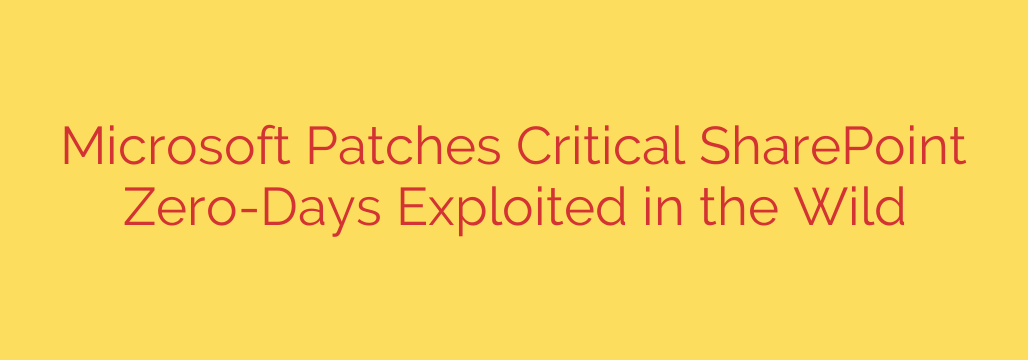
Urgent Security Alert: Patch Your SharePoint Servers Now to Block Critical Zero-Day Attacks
A severe security vulnerability is being actively exploited in Microsoft SharePoint Server, creating a significant risk for organizations that have not yet applied the latest security updates. This critical flaw allows attackers to gain complete control over vulnerable servers, potentially leading to data theft, ransomware deployment, and further network compromise.
If your organization uses Microsoft SharePoint Server, immediate action is required to protect your sensitive data and infrastructure.
Understanding the Double-Threat: A Two-Stage Attack
The threat stems from two distinct vulnerabilities that attackers are chaining together to achieve their goals. This method makes the attack highly effective and dangerous.
The first vulnerability, tracked as CVE-2023-29357, is a critical privilege escalation flaw. This allows an unauthenticated attacker—someone without any login credentials—to gain administrator-level privileges on the SharePoint server. This flaw is especially dangerous because it requires no user interaction and can be exploited remotely over a network.
Once an attacker has gained admin rights, they can leverage a second vulnerability, tracked as CVE-2023-24955, to achieve remote code execution (RCE). This means the attacker can run any code they want on the compromised server.
In simple terms, the attack works like this:
- The attacker uses the first flaw to become an administrator.
- With their new admin powers, they use the second flaw to execute malicious commands.
This two-step process gives a remote, unauthenticated attacker a direct path to a full server takeover.
The Impact: Why This Is a Critical Priority
A compromised SharePoint server is a worst-case scenario for any organization. SharePoint environments often store a company’s most valuable and sensitive information, including financial records, intellectual property, customer data, and strategic plans.
An attacker with administrator-level control and remote code execution capabilities can:
- Steal, modify, or delete all data stored on the SharePoint server.
- Deploy ransomware to encrypt your files and demand a payment.
- Use the server as a launchpad to move laterally across your network, attacking other systems.
- Install persistent backdoors to maintain long-term access to your environment.
Because these vulnerabilities are being actively exploited in the wild, this is not a theoretical threat. It is a real and present danger to unpatched systems.
Your Immediate Action Plan: Patch and Secure
The only effective way to neutralize this threat is to apply the security updates released by Microsoft. Waiting to patch is not an option, as automated scans are likely already searching for vulnerable servers.
All administrators of Microsoft SharePoint Server 2019 are urged to install the latest patches immediately.
Beyond this urgent patch, this incident serves as a critical reminder of the importance of proactive security measures.
Proactive Security Tips to Harden Your SharePoint Environment
While patching is the immediate priority, you can take additional steps to improve your long-term security posture and defend against future attacks.
- Implement a Strict Patch Management Policy: Don’t wait for zero-day alerts. Ensure all systems, including servers and applications, are patched on a regular, predictable schedule.
- Enforce the Principle of Least Privilege: User and service accounts should only have the minimum permissions necessary to perform their functions. This can limit an attacker’s ability to move through your network even if they compromise an account.
- Monitor Activity Logs: Regularly review SharePoint and server logs for unusual activity, such as unexpected privilege escalations or command execution. Anomaly detection systems can help automate this process.
- Segment Your Network: Isolate your SharePoint servers from other critical parts of your network. This can prevent an attack on one server from spreading to your entire infrastructure.
- Use a Web Application Firewall (WAF): A properly configured WAF can provide an additional layer of defense by filtering malicious traffic before it ever reaches your SharePoint server.
The threat landscape is constantly evolving, and vulnerabilities in widely used platforms like SharePoint will always be a prime target for attackers. Taking swift action now and adopting a defense-in-depth security strategy is the best way to protect your organization’s critical assets.
Source: https://go.theregister.com/feed/www.theregister.com/2025/07/22/microsoft_sharepoint_2016_patch/








